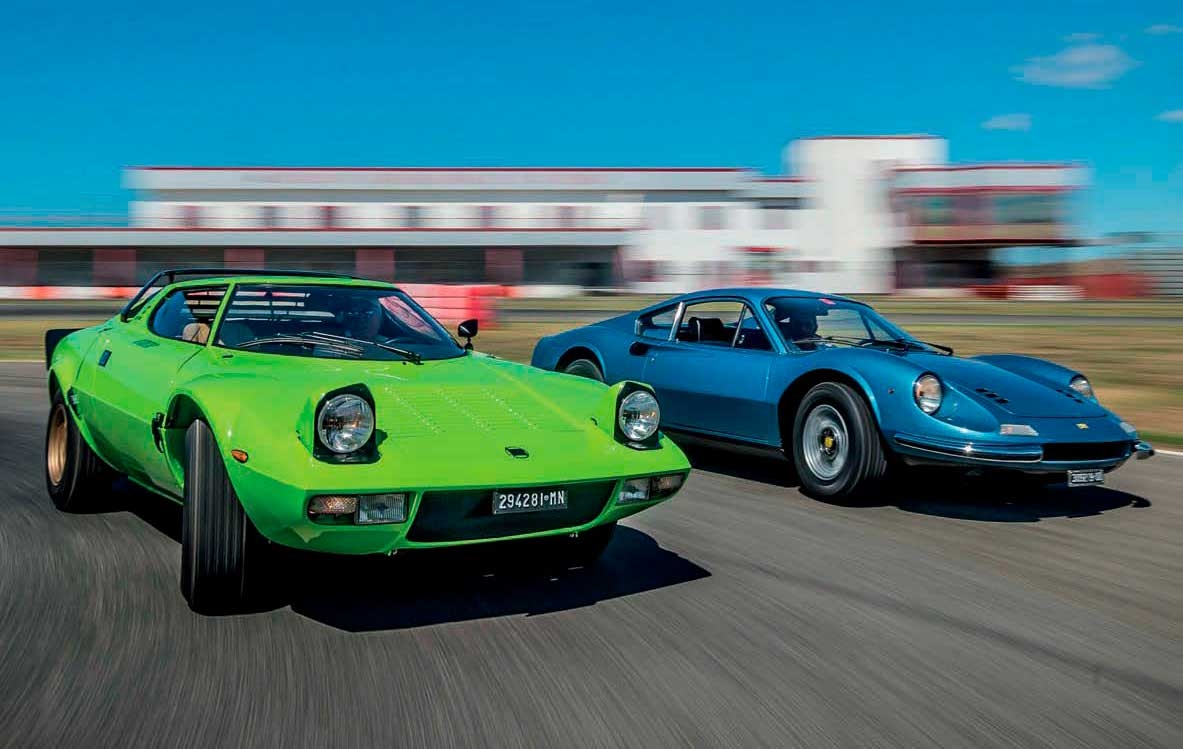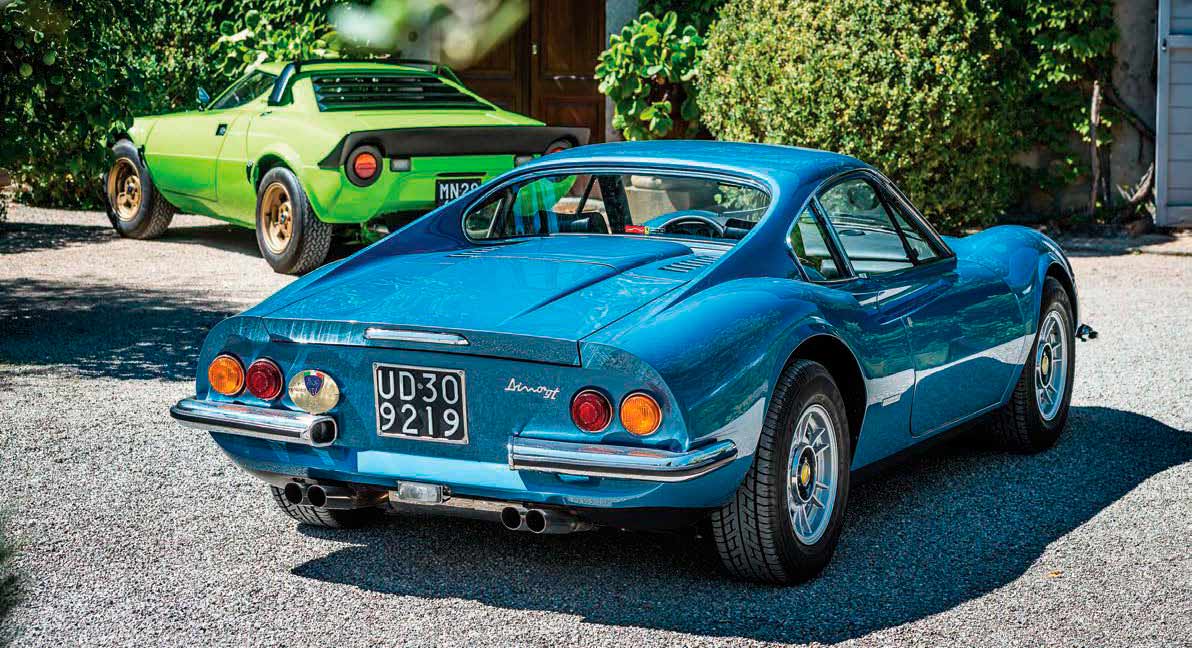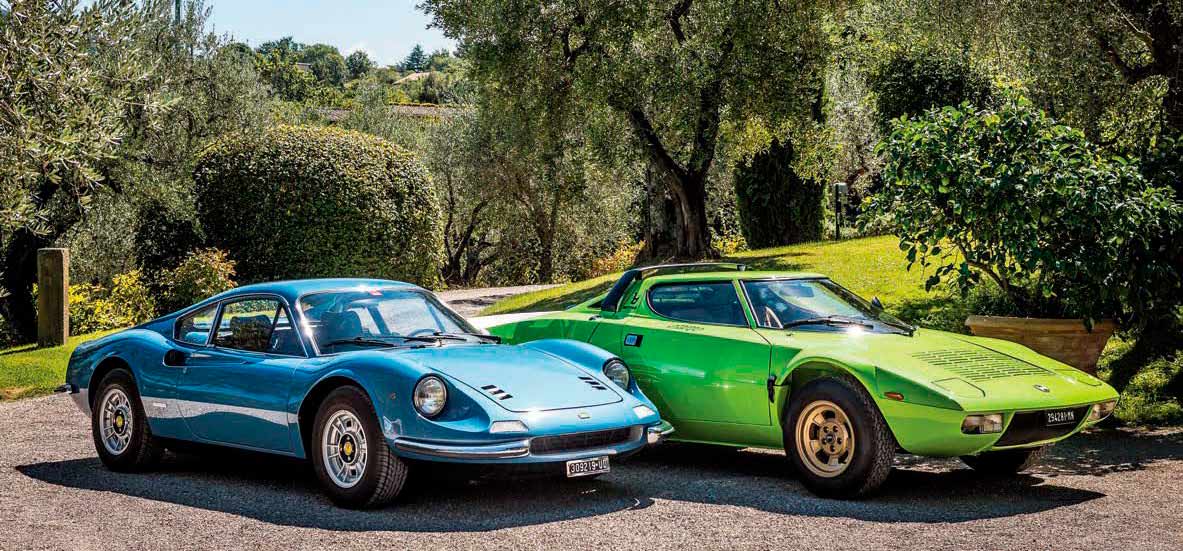
Lancia Stratos vs Dino 246 GT. Same engine, utterly different drives Heart of the Matter Despite having the same Ferrari-designed mid-mounted V6 engine, these two Italian icons – 1974 Dino 246 GT and 1976 Lancia Stratos – have very different characters. Story: Drive-My/Gaetano Derosa. Images: Drive-My/Massimiliano Serra.
Blood Brothers: Lancia Stratos HF vs Ferrari Dino 246 GT
Two cars, one engine. To be specific, a Dino 246 GT and a Lancia Stratos HF fitted with a 65-degree V6 Dino engine conceived by Enzo Ferrari. Yet these two mid-engined 1970s masterpieces are like chalk and cheese to drive. The question is, do you prefer your mid-engined Italian icon in ‘Rally’ or ‘Road’?

Despite the similarities – mid-engined configuration, surprisingly compact dimensions, same basic suspension layout – the contrasts between the two cars are huge. The differences start as soon as you set eyes on them. Each of these cars has an essential beauty, that’s for sure, but while the Dino is classically elegant, the Stratos is more brazen, with a definite nod to 1970s sci-fi sensibilities. These cars are also among the highest performers in terms of classic values. If you want one, a Dino will now set you back at least £250,000, and a genuine Stratos more like £450,000.
So how were these two related thoroughbreds born? Answer: from a resolute scribble by Enzo Ferrari: “No, we are not almost there yet!”, written in his famous purple ink on the bottom of attachment number 17, at 10pm on a gloomy Monday – specifically 20 May 1963. The Commendatore, accompanied by his faithful assistant, Franco Gozzi, was about to sign a technical and corporate agreement with Ford in Modena, but after re-reading all the typewritten pages drafted by Ford’s lawyers, he suddenly appreciated the extent of the modifications that had been made to the draft of five days earlier. And when he started reading the notorious Annex 17, concerning the racing department’s expenses, he realised that the agreement would never become reality. Barely restraining himself from knocking his desk over, he shouted out loud: “See what’s written here? I have to seek permission from America if I spend more money on racing!

Does the English text say the same?” Mr Gozzi nodded. Ferrari fumed: “I’ve been cheated, fooled, betrayed! You and I are going out for lunch now, Gozzi!” They both headed to the Cavallino restaurant, where Enzo sat at his usual table and burnt off his anger with a dish of spaghetti with meat sauce and a glass of wine.
For Mr Ferrari, the abrupt interruption of negotiations with Ford paved the way for the beginning of an alliance (technical at first, then corporate) with Fiat. In the first days of January 1965, Fiat’s deputy president, Gaudenzio Bono, accompanied by Weber director, Francesco Bellicardi, met the Drake at Maranello to sound out his interest in producing an engine aimed at obtaining homologation (500 units over the course of a year). The agreement, allegedly concluded by way of smiles and pats on the backs on 1 March 1965, stated that the Emilian manufacturer would make a Formula 2 engine for the 1967 season and onwards, while Fiat, for its part, would obtain a six-cylinder engine for a road car of its own.

The engine would bear the name Dino, after the son of Enzo Ferrari, who had died prematurely at the age of 24 of muscular dystrophy, on 30 June 1965. In his last months of life, Enzo’s son had laid the ground for the creation of a 65-degree V6 engine with the help of Vittorio Jano. That project, locked away in a drawer by Enzo Ferrari after the loss of his beloved son, would now reach reality in association with Fiat. The Commendatore commented to his assistant Gozzi: “I am proud that Italy’s largest automotive company will build a sports car with the name Dino.”
DELICATE DINO
Simultaneously at Maranello, the way was paved for the production of a new sports car. The starting point was the spectacular Pininfarina Berlinetta Speciale designed by Aldo Brovarone. 1967 saw the birth of the production Dino 206 GT on a Tipo 607 chassis. It was sold by Ferrari under the Dino brand name with the slogan: “Small, zippy, safe… almost a Ferrari.” That sounded, perhaps, like an insult for such a beautiful car.
The Dino 206 was equipped with an evolution of the V6 engine, which was originally 1586cc in competition spec but was soon brought up to 1986cc. While the 206 GT would be manufactured in as few as 153 examples over the course of 18 months, its replacement, the 246 (first presented at the 1969 Turin Motor Show) would have much greater success.
“Dino: from the Tasmanian Cup to the 246 GT” was the superb advertising slogan created to promote the car. The ad hinted at victory in the Australian singleseater Formula season by Chris Amon and Derek Bell. The V6 engine was expanded to 2418cc and received a cast iron block instead of the previous aluminium one, while power went up from 180hp to 195hp. The 65-degree V6 (type 135 CS) of the Dino 246 GT differed from that of the Lancia Stratos in its intake manifold, vertical (not inverted) Weber carburettors and a modified air filter.
To be in the Dino’s presence reminds you of the mythical Sport Prototype 330P3/4, whose modernity, as Sergio Pininfarina later confirmed, would serve as the basis for the creation of the Ferrari 308 GTB and other models.
STELLAR STRATOS
The Lancia Stratos HF is the half-sister of the Dino 246 GT. The engine may be the same (although with the ‘L’ of Lancia stamped on the cylinder heads) but the car’s genesis was completely different.
The design came from the pencil of Marcello Gandini at Bertone, who visualised the concept in a surprise dream car at the Turin Motor Show in 1970: Strato’s (with an apostrophe) was its official name but it was renamed Zero later on. The former name originated from Gandini himself, as he was passionate about aircraft modelling and was completing a Stratos aircraft model at the time: the apostrophe was initially added for differentiation purposes but abandoned shortly after, although it remains on the flanks of the road berlinetta.

To make the show car, Bertone secretly bought a second-hand Fulvia HF 1.6 and had it broken down into pieces to cannibalise the mechanical organs, mounting the engine centrally. In those years, Lancia was far from thinking of an heir to the Fulvia Coupé. Only sporting director Cesare Fiorio hoped for a new weapon to match the might of the Alpine A110 and Porsche 911 in rallying. If the first draft of the Stratos is owed to Bertone, the project’s subsequent development was down to Fiorio and Ugo Gobbato, Lancia’s general manager at the time – as well as a good friend of Enzo Ferrari. Gobbato was secretly supported by Gianni and Umberto Agnelli at Fiat, and was determined to get on with the project, despite the many difficulties.
The biggest obstacle, for sure, was the choice of engine. Nobody outside the racing department seemed to have a clear idea on the subject. The technical managers only wanted a Lancia engine, even though that would imply going back to the glorious V6 designed by Francesco De Virgilio for the Aurelia. Gandini and Fiorio dreamed of the Dino engine, which is why it was given such a large engine compartment in its tubular subframe. Due to the unavailability of an engine, the 1971 road prototype was exhibited at the Turin Motor Show with no ‘heart’.
A call by Enzo Ferrari to Gobbato in December 1972 helped break the stalemate. The former head of Lancia’s racing department, Gianni Tonti, recalls: “Fiat was reluctant to let us use the Dino engine, which was going out of production. We also sounded out the idea of the 90-degree, 3.0-litre V6 from the Maserati Merak.
When we received that phone call from Maranello, allowing us officially to use the Dino’s V6, we were so happy that we celebrated until late that night.”
The Stratos famously secured three World Rally victories from 1974 to 1976 and more than 100 races on the top step of the podium. Its total dominance ceased only for political, rather than technical, reasons in 1977, when Fiat, which had acquired Lancia in the meantime, decided that the 131 Abarth should become its rally weapon. The switch was made regardless of the fact that Sandro Munari won the Monte Carlo Rally in a Stratos in 1977. Munari still gets carried away in discussions today, if you mention his favourite car. “It is always a pleasure to drive it, whether that’s on the road or in races. Engineers literally sewed it on me. I always laugh at the silly talks about ideal cars for drifting. The Stratos is the only one that drifts exactly as it takes. The others are just bar talk.”
The 1974 Dino 246 GT and 1976 Lancia Stratos featured in this article belong to a private collector who’s based in central Italy. Both were fully dismantled before undergoing a complete and accurate restoration, and are superb representatives of their type.
HEAD TO HEAD ON THE ROAD
What really strikes you about the Dino 246 is its agility and delicacy. The power available may not be massive, but in this lightweight frame, it’s lively enough. Most of the pleasure is to be found at the top end. Although there’s a decent slug of torque from as low as 1500rpm, the fun zone is really in the spiral from 5000rpm up to the redline of almost 8000rpm. The Dino reaches high speeds in double-quick time and it’s not hard to see why so many drivers in period regarded the Dino as more desirable than a ‘real’ Ferrari.
You drive it with the precision of a go kart, even sitting as low as kart, almost on the ground in fact, with the luscious front wings in full view. The driving position can feel odd, due to the offset pedals and low-set steering wheel, but the rack-and-pinion steering offers old-school feel aplenty and superb sharpness. The handling is sweet, precise and ultimately benign, with a surprisingly good ride quality too. There’s minimal body roll and it behaves itself around corners, understeering with the throttle on and tucking in predictably on lift-off.

The Stratos, in contrast, feels very much the rallybred monster. From the moment you fire it up – it has a much louder soundtrack than the Dino – it feels rawer. Avoid the Webers loading up at low revs and acceleration from 4000rpm upwards is fiercely savage in every gear. Finding reverse gear may be a challenge, but the move to dog-leg first and then through the rest of the gate is painless.
The Lancia’s steering is quick and very light, and the shorter wheelbase and wider tracks of the Stratos make it feel even more eager and agile than the Dino in the handling department. As the first corner approaches, there’s more than a twinge of anticipation; the Stratos’s reputation for being unforgiving is something you never want to forget. But the steering is ultra-direct: one tiny movement of the wrists translates to a change of direction so instantaneous that it’s almost psychic. As your time spent in the company of the Stratos grows, you feel it respond with ever more confidence through the corners, with a near-complete absence of body roll – it’s really quite magical. One distinct negative, though, is the shocking visibility.
Dino has delicate handling balance, Stratos can bite hard if provoked, due to its shorter wheelbase. Banana-shaped seats in both cars are very 1970s – they look great but aren’t really that comfortable.
In terms of size and mechanical layout, this pair is very close, but they drive utterly differently. Dino’s classically elegant lines contrast with the more brazen, in-your-face shape of the Lancia Stratos.
| CAR: | LANCIA STRATOS HF TYPE 829 | DINO 246 GT |
| ENGINE: | 2418cc V6 DOHC | 2418cc V6 DOHC |
| BORE X STROKE: | 92.5mm x 60mm | 92.5mm x 60mm |
| COMPRESSION RATIO: | 9.0:1 | 9.1:1 |
| POWER: | 190hp at 7000rpm / DIN | 195hp at 7600rpm / DIN |
| TORQUE: | 159lb ft at 4500rpm / DIN | 167lb ft at 5500rpm / DIN |
| INDUCTION: | 3 x Weber 40 IDF | 3 x Weber 40 DCNF |
| TRANSMISSION: | 5-speed gearbox, RWD | 5-speed gearbox, RWD |
| TYRES: | 205/70 VR14 | 205/70 VR14 |
| SUSPENSION: | Wishbones, coil springs, anti-roll bar & hydraulic dampers front & rear | |
| BRAKES: | Discs front and rear | Discs front vented and rear |
| FUEL TANK: | 80 litres | 70 litres |
| WHEELBASE: | 2180mm | 2340mm |
| TRACK: | 1430mm (front), 1460mm (rear) | 1420mm (front), 1430mm (rear) |
| DIMENSIONS: | 3710mm (L), 1750mm (W), 1110mm (H) | 4200mm (H), 1700mm (W), 1115mm (H) |
| WEIGHT: | 980kg | 1080kg |
| MAX SPEED: | 147mph | 148mph |
| 0-62MPH: | 6.8sec | 7.4sec |
| 0-100MPH: | 16.0sec | 17.4sec |
| 1KM STANDING START: | 26.7sec | 27.1sec |
| NOISE AT 85MPH: | 84dB | 81dB |
| FUEL CONSUMPTION: | 22mpg | 21mpg |
| PRODUTCION RUN: | 512 | 2487 (all versions) |





